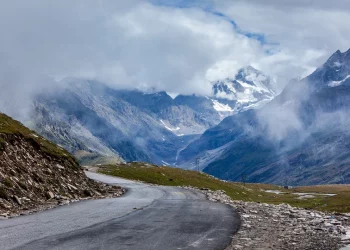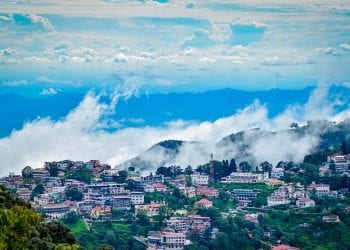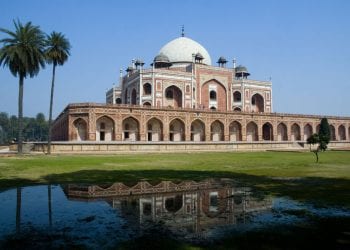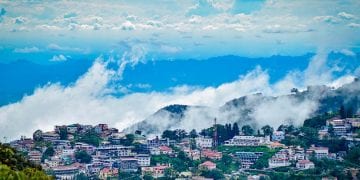Visit the Top Temples in Guwahati for a Uniquely Spiritual Experience
Guwahati, the gateway to the Northeast of India is a bustling city perched on the banks of the mighty Brahmaputra River, the second-longest river in India. As it is a busy city, it is easy to miss out on the historically relevant places in Guwahati. However, there are quite a few beautiful religious sites here, which will surely appeal to those who are spiritually inclined or looking for a peaceful vacation. The Ahom kings, who are one of the longest-ruling dynasties of the world and witnessed an uninterrupted rule of 600 years, have left behind many monuments that speak volumes about their keen cultural inclination. Visit the temples in Guwahati and get an insight into the little-known history of North-eastern India.
Top 9 Temples To Visit In Guwahati
- Kamakhya Temple
- Navagraha Temple
- Umananda Temple
- Doul Gobinda Temple
- Purva Tirupati Sri Balaji Temple
- Aswaklanta Temple
- Ugratara Temple
- Basistha Temple
- Lankeshwar Temple
1. Kamakhya Temple
One of the famous Shaktipeethas across India, the Kamakhya Temple is dedicated to Goddess Kamakhya. The temple is situated in the heart of Guwahati on a hilltop and is maintained nicely by the authorities. There are four Garbhagrihas and three mandapas inside the temple and the walls are adorned with many sculptures. One of the unique things in this temple is that there is no idol of the goddess that is worshipped here, and instead, the Yoni or vagina of the Goddess is worshipped in the inner sanctum of the temple.
The hilltop is a great place to gain a view of the entire Guwahati city below and the surrounding atmosphere will bring a sense of calm. The temple looks very beautiful during the evening Aarti. This is the most famous among the religious sites in Guwahati.
Ambubachi Mela is the most important festival of the temple which happens for 4 days every year. This is the time when the Goddess Kamakhya is supposed to be undergoing her yearly menstrual cycle. Devotees from all over the country flock to the temple at this time.
Getting there: Kamakhya temple is well-connected by various means of transport such as public buses, shared taxis and private taxis. Irrespective of wherever you are in the city, all these modes of transport are easily available.
Best time to visit: The best time to visit Kamakhya Temple is during the months of October to February.
2. Navagraha Temple
The Navagraha Temple or literally the temple of nine celestial bodies is another temple situated on a hill in the south-eastern part of Guwahati. The temple is said to be more than 1000 years old, but over the years, earthquakes and other natural calamities have damaged it. The present-day temple was built by the Ahom king Rajeswar Singha in 1752 A.D. The inner sanctum of the temple has 9 lingams of Lord Shiva that are clad in different colours to represent the different planets – Surya, Chandra, Mangal, Budha, Brihaspati, Shukara, Shani, Rahu, and Ketu. Devotees from all across the state come to this temple to offer prayers and pujas so that the planets are appeased, and no problems befall them. This is one of the most visited religious sites in Guwahati.
Getting there: The temple is well connected with buses and private taxis. The best way to reach there is by a private taxi.
Best time to visit: The best time to visit the Navagraha temple is between the months of October and February.
3. Umananda Temple
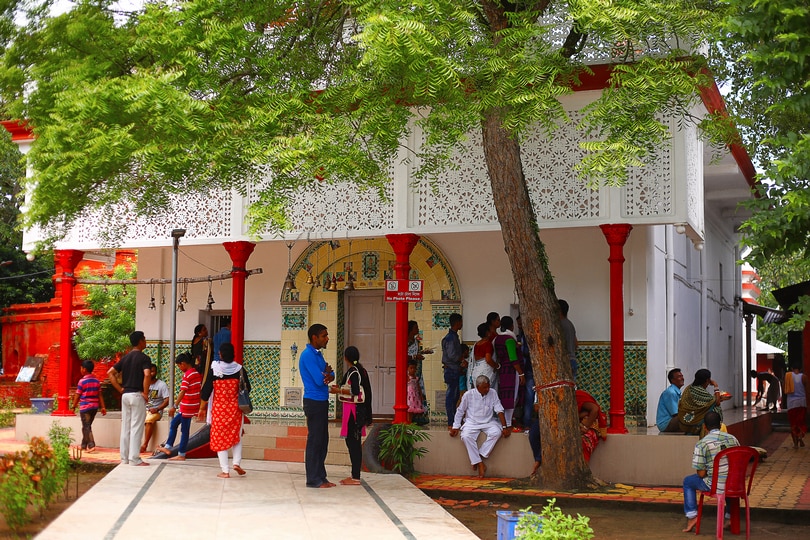
The spellbinding Umananda Temple is in the middle of the Brahmaputra River on an island known as the Umananda Island or Peacock Island. The temple is dedicated to Lord Shiva and it was built by the Ahom king Gadadhar Singha in 1694. The presiding deity here is Lord Umananda who is another avatar of Lord Shiva. According to locally held beliefs, Lord Shiva used to reside in this place and was meditating here when Kamdeva, the lord of love, interrupted his meditation. An angry Shiva reduced Kamdeva to ashes with just one look. The ashes were scattered at this spot and that is the reason that the hill where the temple is located is known as bhasmachala. Shivaratri is the major festival here, which attracts visitors and devotees alike. The temple has a number of sculptures made out of rock and the temple also has archaeological significance. Apart from the religious and archaeological significance, the natural beauty and the sights from the island will definitely mesmerize you.
Getting there: There are government-run ferries that ply to and from the island throughout the day.
Best time to visit: The best time to visit is during the winter months of October to February.
4. Doul Gobinda Temple
Among the most famous religious sites in Guwahati and in Assam, the Doul Gobinda Temple deserves special mention. It is on the foothills of the Chandrabati Hills, in North Guwahati. The temple is dedicated to Lord Krishna and is not only visited by Krishna devotees, but by people of all religious faiths.
The temple witnesses maximum footfalls during Holi. The festival of colours is celebrated here for a period of five days. Janmasthmi is another major festival in India that is celebrated here.
The temple is near the shores of the Brahmaputra River and is not crowded. The banks of the river are an ideal picnic spot too.
Getting There: The easiest way to reach Doul Gobinda is by availing ferry boat services from Fancy Bazaar.
Best time to visit: The best time to visit is between the winter months of October and February.
5. Purva Tirupati Sri Balaji Temple

The Tirupati Balaji Temple of Guwahati is dedicated to Lord Venkateshwara and has South Indian style of architecture. Visitors first visit the temple of Ganesha that is at the entrance and then goes on to visit the Balaji temple. The presiding deity here is Lord Balaji while other deities include goddesses such as Padmavathi and gods such as Garuda. The temple has a deity of Lord Shiva whose age is more than 40 years old. The white spotless walls here lend a special kind of beauty to the place.
The South Indian style of construction is very prominent. Once you’re done with your prayers, you can also sit and relax in the beautiful park associated with the temple. The prasadam here is in the form of ladoos that are given in the original Tirupati Balaji Temple in Tamil Nadu. Although very modern, this is one of the most visited sites in Guwahati.
Getting there: The temple, although on the outskirts of the city, is well -connected by buses and taxis.
Best time to visit: The best time to visit is between October and February
6. Aswaklanta Temple
Sri Aswaklanta Temple is an ancient Hindu temple located on the banks of the River Brahmaputra in North Guwahati. It is another one of the popular religious sites in Guwahati. It was built by the Ahom king Shiva Singha in 1720. The temple was damaged in the great earthquake of 1897, but it was repaired in 1901 under the patronage of Lord Curzon, viceroy of Assam.
There are two main deities in the temple. They are Lord Janardana and Lord Anantasai Vishnu. The temple has beautiful stone inscriptions on all its walls and the sculptures here are fine specimens of rock-cut architecture.
There are two legends associated with the name of this place. The first one says that when Lord Krishna was searching for the demon Narakasur to kill him, his horse felt tired here at the spot where the temple is today. Aswa means horse and klanta mean tired in the Assamese language. Thus, the name Aswaklanta was given to the temple.
The second legend says that owing to a conspiracy, Arjuna, the third brother of the Pandavas, was persuaded to stay here so that in the meantime his son Abhimanyu could be killed in battle. This gave the name Abhi-Klanta to the place which later changed into Aswaklanta.
The festivals that are celebrated with great pomp and gaiety are Janmashtami and Ashokasthami. The temple remains crowded during these occasions as devotees come from afar to see these festivals.
Getting there: The temple is easily accessible by both water and road transport. There are ferries from Fancy Bazaar ghat and taxis and buses are available to go to the temple via road across the Saraighat Bridge.
Best time to visit: The best time to visit the temple is between October and February.
7. Ugratara Temple
Ugratara Temple is another Shakti Temple which sees flocks of devotees and tourists. The temple is dedicated to Sati Devi, the first partner of Lord Shiva. The temple was constructed in the year 1725 by the Ahom king Siva Singha. Beside the temple is the famous Jor Pukhuri. Just like the Goddess Kamakhya, there is no idol of the Goddess Ugratara here. Instead, a small ditch of water is worshipped here which is considered to be a form of the Goddess Ugratara. The goddess is believed to be a demonic form of Goddess Sati so it is said that she loves liquor, meat, and complete devotion. You can either offer puja at the temple or simply witness a puja. Animal sacrifice is still in vogue here and animals such as goats or buffaloes are sacrificed during the Durga Puja and Kali Puja. The earthquake of 1897 had damaged this temple too but it was repaired.
Getting there: Since the temple is centrally located in the heart of the city, transportation is not an issue. Buses, auto-rickshaws, and rickshaws are available aplenty.
Best time to visit: The best time to visit the temple is during the Durga Puja and Kali Puja.
8. Basistha Temple
The Basistha Temple is among the interesting religious sites in Guwahati and is dedicated to Lord Shiva. It was constructed by the Ahom king Rajeshwar Singha in the year 1764. The temple is inside an ashram known as Basistha ashram which is a place of great scenic beauty. It is believed that a sage named Basistha once lived here and today the resting place of the sage is also the place where the ashram is. One of the prime attractions here is a cave where the sage is said to have meditated. There is also a beautiful waterfall here. The Garbhanga Reserve Forest is also near the ashram and is home to many wild animals including elephants.
Getting there: There are shared cars known as trekkers and buses that drop you right near the temple.
Best time to visit: The best time to visit is between the months of October and February.
9. Lankeshwar Temple
This is another ancient temple atop a hill which is considered very sacred among devotees. The temple is on the outskirts of the city, near Gauhati University. It is well connected by different transport modes and is in a scenic location. The view from the top of the hill is marvellous as you can see the Brahmaputra River in the distance and parts of the Guwahati city too.
The temple attracts devotees in large numbers during Shivratri.
Getting there: City bus number 6 directly connects Guwahati city and the temple. It is the easiest and cheapest way to get to the temple. Private taxis are also available to go to the temple from central points in the city such as Khanapara and Paltan Bazaar.
Best time to visit: The best time to visit the temple is between the months of October and February.
To conclude
In Guwahati, be prepared to explore temples that have their own distinctive look and are different from what you might be used to seeing otherwise in India. Guwahati is also the connecting point for many beautiful spots in Assam and other states. The winter months between October and February would be the best time to visit as they are the months when temperatures are mild and the city doesn’t experience too much heat or too much rain.
P.s. You might like this related resource:
Recent Posts
Top Picks

- OYO
 15 April, 2024
15 April, 2024 - Cultural Tour

- OYO
 15 April, 2024
15 April, 2024 - Cultural Tour

- OYO
 15 April, 2024
15 April, 2024 - Cultural Tour

- OYO
 15 April, 2024
15 April, 2024 - Cultural Tour

- OYO
 15 April, 2024
15 April, 2024 - Cultural Tour

Please rotate your device
Please go back to portrait mode for the best experience




 April 15, 2024
April 15, 2024 